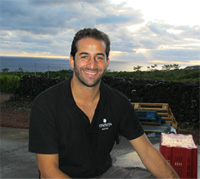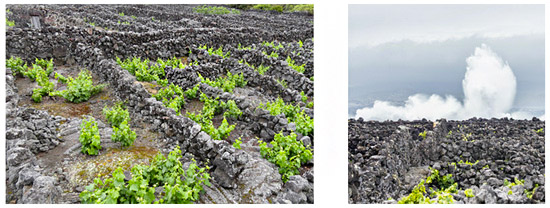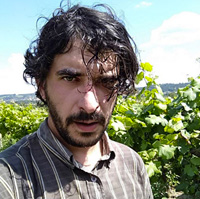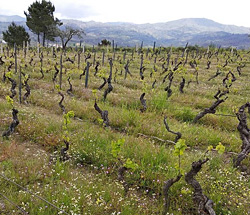| « Previous | News | Next » |
January 23, 2019
A Tale of Two Antónios
António Maçanita and António Madeira are defining what is possible for Portuguese wine. Dedicated and brilliant vignerons, they both embrace indigenous grapes and artisan methods to produce terroir-driven wines with real individuality.
António Maçanita
 António Maçanita crafts wines everywhere from the Azores archipelago to Alentejo. Each project is devoted to the specific terroir and presents a different challenge. And Maçanita loves a challenge.
António Maçanita crafts wines everywhere from the Azores archipelago to Alentejo. Each project is devoted to the specific terroir and presents a different challenge. And Maçanita loves a challenge.
In 2010, Maçanita decided to explore the Azores because of his family’s history (his father is from the Azores). The Azores archipelago is home to a winemaking tradition that dates back to its colonization in the 15th century. The nine islands are home to a singular terroir and microclimate, one that draws close comparison to the Santorini. Like Santorini, the Azores are volcanic islands comprised entirely of black basalt (pictured below). In 2010, most vineyards were abandoned, and the grape varieties were on the brink of extinction (89 plants of Terrantez do Pico existed). Maçanita references in his interview with Levi Dalton for I’ll Drink to That! that someone suggested the grapes were abandoned because they didn’t make good wines. Challenge accepted. The first vintage of Maçanita’s Azores wines were amazingly fresh, crisp and briny…these grapes do make delicious wines! Today, nine years later, 800 hectares have been planted, and much of this is because of Maçanita’s dedication and passion in reviving the Azores terroir.

Fitapreta is Maçanita’s Alentejo project with David Booth, a British-born viticulturist. Established in 2004, Fitapreta operates on the Portuguese idea of “palpite” or intuition when it comes to viticulture and winemaking. Alentejo is a warm region full of sun. The challenge for Maçanita here is balance. Trust in the land and the natural growth cycle of the vineyard enables him to make wines that show a singular sense of place. The very best sites are composed of mineral-rich rocky schist and have the capacity to limit vine vigor. Grapes are manually harvested early in the morning. Maçanita does not use pumps; Fitapreta is a gravity-fed operation to avoid any harsh treatment of the must. All wines are spontaneously fermented with indigenous yeast. Small parcels of each vineyard are fermented separately to preserve distinct stylistic qualities. These are then blended to achieve a layered, complete picture of the terroir.
António Madeira
 António Madeira is deeply dedicated to the Dão—his adopted homeland in north-central Portugal—and has set out to identify and classify its “grand cru” vineyards and preserve its most ancient ones. Madeira is a Parisian of Portuguese ancestry with family roots in Serra da Estrela, mainland Portugal’s highest mountain. António believes this mountainous area, or “Dão Highlands” as he calls it, is the best region for producing fresh and mineral wines. Indeed, Madeira is crafting phenomenal, terroir-focused wines and showing the potential of this oft-overlooked region.
António Madeira is deeply dedicated to the Dão—his adopted homeland in north-central Portugal—and has set out to identify and classify its “grand cru” vineyards and preserve its most ancient ones. Madeira is a Parisian of Portuguese ancestry with family roots in Serra da Estrela, mainland Portugal’s highest mountain. António believes this mountainous area, or “Dão Highlands” as he calls it, is the best region for producing fresh and mineral wines. Indeed, Madeira is crafting phenomenal, terroir-focused wines and showing the potential of this oft-overlooked region.
In 2011 he produced his first wines after discovering a 50-year-old vineyard in the foothills. He quickly realized he’d stumbled upon gold in the Dão: old vines of native varieties such as Tinta Pinheira, Negro Mouro, Tinta Amarela, and Baga; free-draining granite soils; and excellent sun exposures. Today, he works with small plots in six different villages and farms organically and manually, plowing with a horse. He discovers these old vine plots by speaking with the older generations still living in the area. Sadly, he’s found that around 90% of the old vines have disappeared in the last 30 years. All of his wines are co-fermented field blends, using indigenous yeast and low sulfites.
 This whole vinous labor of love was, until recently, made in the garage at his parents’ vacation home in the Serra da Estrela. But his wines have been so well received that he’s been able to construct a new winery and to trade in his day job as an engineer in Paris to make wine full-time in the Dão, bringing his wife and two daughters with him. With a keen eye on micro-parcels and historic preservation, he’s one of the most exciting producers in the region today.
This whole vinous labor of love was, until recently, made in the garage at his parents’ vacation home in the Serra da Estrela. But his wines have been so well received that he’s been able to construct a new winery and to trade in his day job as an engineer in Paris to make wine full-time in the Dão, bringing his wife and two daughters with him. With a keen eye on micro-parcels and historic preservation, he’s one of the most exciting producers in the region today.
CURRENT STOCK
Fitapreta
2017 ‘A Touriga Vai Nua’ Touriga Nacional - a Touriga that is fresh and light on its feet; this has vibrancy mixed with complex fruit flavors.
2016 Tinto - juicy, ripe fruit with oak comfort; this is a wine for all you California Cabernet lovers!
Azores Wine Company
2016 Verdelho o Original - vibrant and fresh with sea spray and tropical notes.
2017 Arinto dos Acores - salt and mineral rocks with an oily texture, this wine is begging for seafood. Try mussels.
2017 Rosé Vulcanico - strawberry jumps out of the glass; there is weight on the palate from malolactic fermentation. This is an excellent winter rosé.
2016 ‘Isabella a Proibida’ Tinto - 100% Isabella (have you had this grape?), and a passion project for António. Salinity and acid mixes with funky, wild notes; a super interesting and rare wine.
António Madeira
2015 Branco - lemon, apple, pear, buttery weight; this incredibly flavorful white wine can rival Chardonnay.
2015 Vinhas Velhas Tinto - pepper spice blends with red fruit; a red field blend with good tannin structure. Where’s the beef?
2016 ‘Colheita’ Tinto [coming soon]
